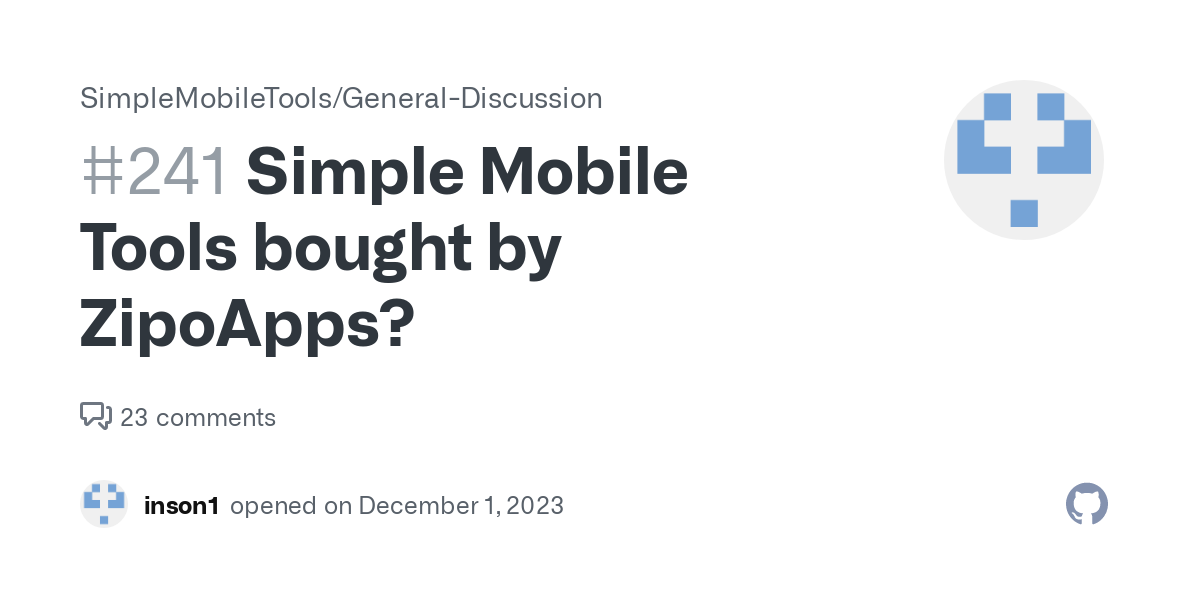pootriarch
a beautiful robot, dancing alone · showgirls über alles: kylie, angèle · masto · last.fm · listenbrainz · lovekylie
- 15 Posts
- 63 Comments

 5·1 year ago
5·1 year agoThe main URL points to this:


 13·1 year ago
13·1 year agoit’s perhaps interesting to see what existing apps ZipoApps has on the Android Play Store.

 1·1 year ago
1·1 year agostrangest thing. i updated firefox and now i have no notifications. only a limited number of sites have notification perms; they still say they have that permission and my system settings still have firefox allowed. i have another machine running ubuntu (with firefox from the PPA for apt) and notifications are unchanged there.
Prerequisites
- Internet-facing web server with reverse proxy and domain name (preferably SSL of course)
- Server behind the reverse proxy with Rust environment
Installation
- Don’t bother downloading the source code to your server; installing it that way gives you a big debug executable
- Instead just
cargo install mollysocket - Move the
mollysocketexecutable if desired - Run
mollysocketonce so that it will emit the default config
Configuration
- Fish the config file out of
.config/mollysocket/default-config.tomland copy it somewhere.
config.toml
- In the new file, replace the
allowed_endpointsline withallowed_endpoints = ['*']. The default 0.0.0.0 config appears to be a bug; this setting controls access to endpoints within the app, not IPs from outside. Leaving the original value causes mollysocket to reject everything. - Put a proper path in the
db = './mollysocket.db'line rather than just having it land wherever you’re sitting. - Delete the
mollysocket.dbthat was created on first run (even if it’s already where you’re intending to put it). This is just to make sure the web server creates it and has the correct permissions.
Run script
- The environment variable ROCKET_PORT must be set or the server will sit and do nothing. It’s best to create all of the environment variables mentioned in the README, whether that is in a user profile script or in a shell script that wraps startup. You can change any of these values, but they must exist.
-
export ROCKET_PORT=8020 export RUST_LOG=info export MOLLY_CONF=/path/to/your/config.toml
Proxy server
- You’ll need to proxy everything from
/to your mollysocket server and ROCKET_PORT. - Exclude anything that you may need served from your web server, such as .well-known.
Things to know
- I get this warning on startup: “Forced shutdown is disabled. Runtime settings may be suboptimal.”
- I also can’t stop my server with any sane signal; only SIGKILL brings it down.
- Some discussion here: https://github.com/SergioBenitez/Rocket/discussions/1880
you probably already found this, but for others who might be curious:
in the settings if you change notification method from websocket to unified push, the UP settings come up, including a server address (which is what they intend to be used) or some air gap mode that i can’t find documented
i’m shopping for mp3 players for precisely this reason - a friend has an ipod touch that abruptly stopped scrobbling. the last.fm app is stuck in a loop sucking battery. and she needs bluetooth anyway. she has always kept music and phone separate but now we have to ask the five whys on that before getting her a new unfamiliar gadget.

 3·1 year ago
3·1 year agoagain not foss so won’t dwell at length — but i use fund manager from beiley software. commercial, but works double-entry and handles more investment complexity than a human could ever need. windows app, i run it under wine on linux and crossover on mac. (i don’t own a windows box — that’s how irreplaceable it was for me.)

 3·1 year ago
3·1 year agoasus pn51, a mini nuc-like box

 1·1 year ago
1·1 year agoso per wikipedia and confirmed at MDN, firefox is the only major browser line not to consider certificate transparency at all. and yet it’s the only one that has given me occasional maddening SSL errors that have blocked site access (not always little sites, it’s happened with amazon).
i don’t understand how firefox can be simultaneously the least picky about certificates and the most likely to spuriously decide they’re invalid.

 1·1 year ago
1·1 year agowell i feel stupid now for not doing the obvious. but…
Blocked Page
Your organization has blocked access to this page or website.
on the PPA box, this is what it showed me (meanwhile it was attempting to connect to incoming.telemetry.mozilla.org). another symptom of displaying respect for enterprise policies but in fact ignoring them. (as i had mentioned, on this box all of the settings look locked down as they should be, but it’s still attempting to send telemetry.)

 51·1 year ago
51·1 year agothanks, i’ll look again. it’s not that i love the idea of being fingerprinted; i just think that five mylar bags, four tin hats and a partridge in a pear tree won’t save me from that. i need my password manager, and once that’s in, enforcing a generic screen is silly - cow’s out of the barn. but not having the arms race against pocket and telemetry would be a big bonus.

 82·1 year ago
82·1 year agoi did try that but the never-dark mode blinded me. i understand the reasoning, but absolute anonymity isn’t my own threat model; i’d like to be able to use themes and resize the window

 2·1 year ago
2·1 year agoan interesting oddity: on my non-rooted xperia, signal thinks that i don’t have play services and so it falls back to… polling. every five minutes. killing my battery and my logs.
i had to put signal into the restricted battery group, which means no notifications. i anxiously await the new molly, as i already have a unified push environment. it looks like the migration will be a bit delicate.

 4·1 year ago
4·1 year agoneo store refuses to run if you don’t grant it the right to send notifications and bypass battery optimizations. if an app demands a permission and doesn’t have a plausible explanation why it needs it, i don’t keep it :/

 2·1 year ago
2·1 year agoimo magic earth is a navigation app, full stop. it does that amazingly well, including live traffic, but i wouldn’t use it for anything else. organic maps is a better general-purpose map but isn’t a patch on magic earth for nav.

 4·1 year ago
4·1 year agoIt exists, it’s called a robots.txt file that the developers can put into place, and then bots like the webarchive crawler will ignore the content.
the internet archive doesn’t respect robots.txt:
Over time we have observed that the robots.txt files that are geared toward search engine crawlers do not necessarily serve our archival purposes.
the only way to stay out of the internet archive is to follow the process they created and hope they agree to remove you. or firewall them.

 4·1 year ago
4·1 year agoi am not sure it’s a flaw at all. the conditional tag syntax is based on opening_hours, which should be able to express ‘closed at these times until that date’. there are ways to finesse this. but as long as the published guideline is ‘don’t do this’, there’s little point pondering practical solutions.

 14·1 year ago
14·1 year agoOur map data is often downloaded and used offline on various devices for several weeks or months. For offline data to be useful, it should at least be expected to remain unchanged in the next few weeks when you map it.
yes, by this blurb, concession for offline users does supersede safety.
i’m an editor active enough to have been granted foundation membership but hadn’t known this rule; it indicates a view of osm as analogous to a paper map rather than for real-time navigation. if a change of less than weeks’ length is discouraged, i can’t in good conscience steer my friends away from google maps, as navigation is not a primary use case.







OSM has a lot more data inside than the website shows - in dense shopping areas you can’t zoom in far enough to see all the POIs, much less business names.
I’ve read before that using cached previews was done to stay accessible to less-powerful mobile devices, which would have smaller CPUs that would be taxed by rendering the native vector data. I view it as a branding disadvantage that OSM appears, from desktops, to have less info than alternatives. But that’s a battle that’s been had many times before, one might as well argue over paper vs plastic.